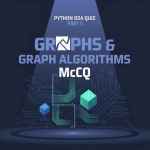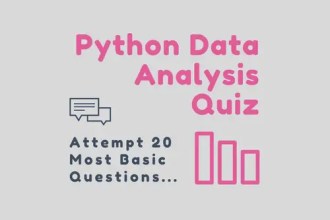Welcome to our Python DSA Quiz – Part 4! 🌳✨ This quiz is designed to test and enhance your understanding of Trees and Binary Search Trees (BSTs). You’ll dive into key concepts such as tree traversals, BST operations, Lowest Common Ancestor (LCA), tree diameter, and more. 🚀
Whether you’re preparing for coding interviews or looking to strengthen your grasp of tree-based data structures, this quiz will help you assess your skills and gain deeper insights into how trees work in algorithmic problem-solving. 💡 Ready to challenge yourself? Let’s get started! 🔥✅
Python DSA Quiz – Part 4
Python DSA Quiz – Part 4 Hints
Here’s a tabular format with hints for each question:
| Q# | Question | Hint |
|---|---|---|
| 1 | Which traversal visits root first? | Think about root-first traversal. |
| 2 | Time complexity of inorder traversal? | You visit each node once. |
| 3 | Data structure for iterative inorder? | Think of LIFO operations. |
| 4 | Which traversal sorts BST nodes? | BST stores values in sorted order. |
| 5 | Avg case search time in BST? | How deep do you go in a balanced BST? |
| 6 | Worst-case insert time in BST? | Consider the shape of an unbalanced BST. |
| 7 | Smallest element in a BST? | Look at the extreme end of the tree. |
| 8 | BST property ensures ordered structure? | The left child is always smaller. |
| 9 | What is LCA in BST? | Think about the lowest shared parent. |
| 10 | LCA search time in balanced BST? | LCA follows the BST search path. |
| 11 | What is tree diameter? | Longest path between two leaf nodes. |
| 12 | Worst-case diameter calculation time? | A naive solution checks every node. |
| 13 | Full tree nodes have how many kids? | Every node should have a fixed count. |
| 14 | Which tree maintains balance? | It automatically rotates to stay balanced. |
| 15 | Height of full binary tree? | A full tree is as shallow as possible. |
| 16 | Rotation for right-heavy left subtree? | Two-step correction needed for balance. |
| 17 | AVL trees are better than BSTs? | Think about height guarantees. |
| 18 | Best structure for expression tree? | Operations are arranged in a hierarchy. |
| 19 | Which traversal evaluates expression trees? | Postfix notation is key. |
| 20 | Key property of max heap? | The largest element is always on top. |
This ensures clarity and provides subtle guidance without directly revealing the answers. 🚀
Summary: Python DSA Quiz – Part 4
Thank you for completing our Python DSA Part 4 Quiz! 🌳✅
In this quiz, we explored essential and advanced concepts related to Trees and Binary Search Trees (BSTs), including tree traversals, BST operations, Lowest Common Ancestor (LCA), tree diameter, and more. We hope this quiz helped reinforce your understanding and provided valuable insights into how tree-based data structures work in problem-solving.
📌 Missed our previous quizzes? Check them out here:
✅ Python DSA Quiz – Part 1 (Core data structures and algorithms)
✅ Python DSA Quiz – Part 2 (Recursion and sorting algorithms)
✅ Python DSA Quiz – Part 3 (Linked lists and fast-slow pointer techniques)
🚀 Stay tuned for more quizzes where we’ll cover even more advanced data structures and algorithms to further enhance your Python programming skills. Don’t forget to subscribe to our YouTube channel for more MCQs, coding challenges, and tutorials! 🎯🔥





